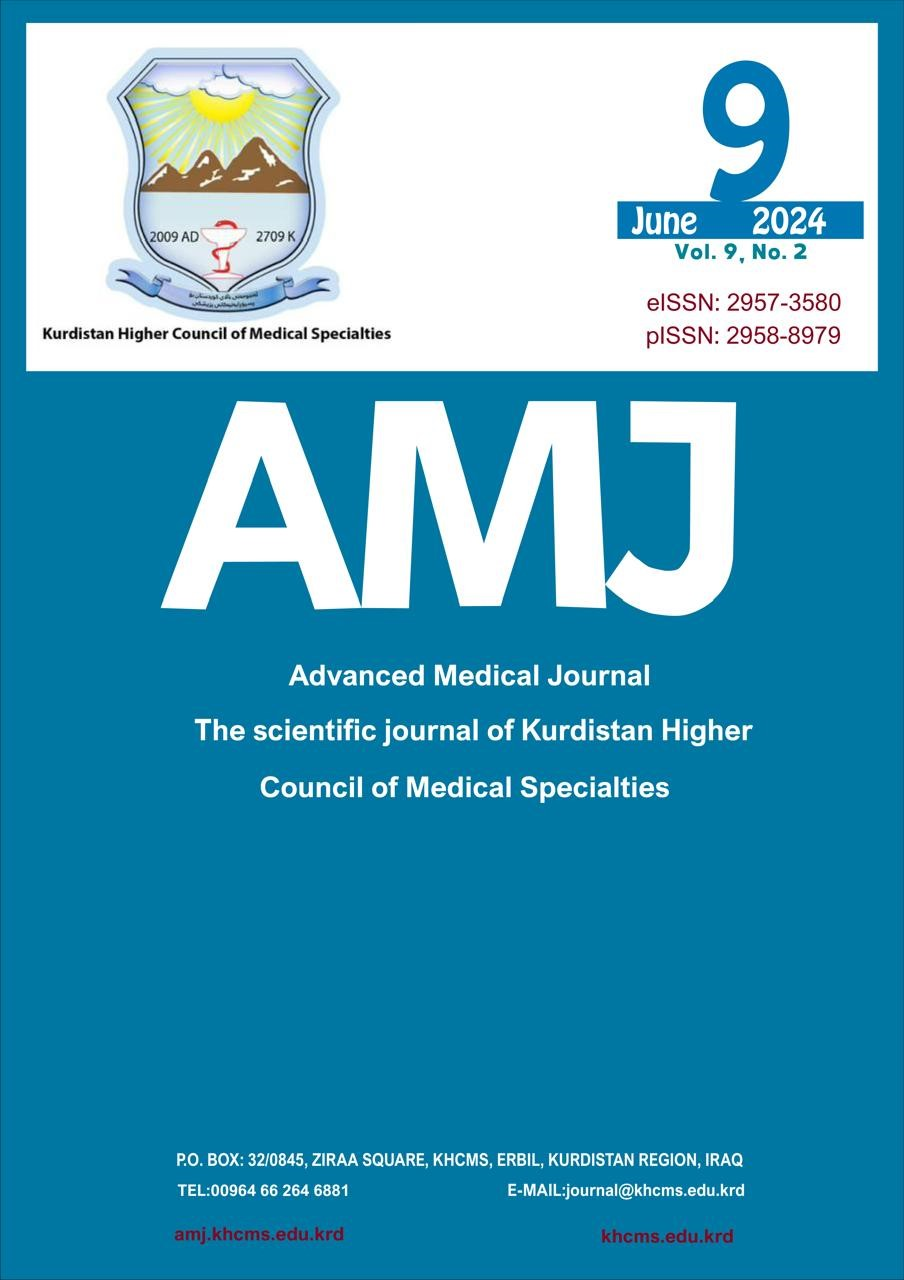Gender differences in Clinical Characteristics and Outcomes of Heart Failure with Reduced Ejection Fraction
DOI:
https://doi.org/10.56056/amj.2024.252Keywords:
Heart failure, Left ventricular systolic dysfunction, Gender differences, Clinical outcomesAbstract
Background and Objectives: Studies evaluating gender differences and outcomes in heart failure with reduced ejection fraction are limited in Iraq. The aim of this study was to assess the clinical characteristics, risk factors, outcomes and severity of heart failure with reduced ejection fraction in both genders.
Patients and Methods: This is a prospective cohort study of 117 patients aged more than 18 years who had been admitted to the Hawler Cardiac Center or medical ward with heart failure with reduced ejection fraction for the period from December 2021 till 30th of October 2022. The clinical characteristics, severity of left ventricular systolic dysfunction and the outcomes over three months were compared between women and men.
Results: One hundred seventeen patients were included in the study, 61 (52.1%) patients were male and 56 (47.9%) were female with male to female ration (1.09:1), p-value (0.017). Women presented with higher incidence of moderate left ventricular systolic dysfunction 36(64.2%), obesity 43 (76.8%) p-value=0.017*, dyslipidemia 27 (48.2%) p-value=0.038, pulmonary hypertension 4 (7.1%), atrial fibrillation 15(26.8%) and high cardiac hospitalization 12 (21.4%), while men have high incidence severe left ventricular systolic dysfunction 33(54.1% ) p-value=0.046, smoking 42 (68.9%); p-value <0.001 and ST-segment elevation myocardial infarction 28 (45.9%) p-value <0.001. the p-values off all above findings are less than <0.05 respectively
Conclusions: There are major differences in risk factors, clinical presentation and outcomes between both genders. The majority of women presented with moderate left ventricular systolic dysfunction and higher rate of cardiac hospitalization while men presented with severe left systolic dysfunction associated with high incidence of ST-elevation myocardial infarction.
Downloads
References
-Lippi G, Sanchis-Gomar F. Global epidemiology and future trends of heart failure. AME Med J. 2020 5(2). 21-29.
-Bahaj AA. Clinical Characteristic and In –Patients Mortality among 100 Patients with Heart Failure Admitted to Ibn Seena Central Hospital, Mukalla, Hadhramout- Yemen. Iraqi J of Med Sc. 2010; 8 (3): 60-68.
-Zangana AH, Al Banna HI. Trend of deaths due to circulatory system in Erbil City between 2007 to 2011. J Fac Med Bagdad. 2016 58(4):361-5.
-Tiller D, Russ M, Greiser KH, et al. Prevalence of Symptomatic Heart Failure with Reduced and with Normal Ejection Fraction in an Elderly General Population–The CARLA Study. PLoS ONE.2013;8(3):124-33.
-Dunlay SM, Roger VL. Gender Differences in the Pathophysiology, Clinical Presentation, and Outcomes of Ischemic Heart Failure. Curr Heart Fail Rep. 2012 9(4):267–76.
- World Health Organization - Regional Office for the Eastern Mediterranean. Report on prevalence of Noncommunicable diseases in Iraq 2019 at https://www.emro.who.int/iraq/priority-areas/noncommunicable-diseases.html
-Damluji SF, Al-Saffar G, Thamer MA, Mary AS. Congestive heart failure in women in Iraq. Bull World Health Organ. 1964;31(3):337–44.
-Vadera BN, Yadav SB, Yadav BS, Parmar DV, Unadkat SV. Study on obesity and influence of dietary factors on the weight status of an adult population in jamnagar city of gujarat: a cross-sectional analytical study. Indian J Community Med. 2010 35(4):482-6.
-Shankar A, Gurumurthy G, Sridharan L, et al. A Clinical Update on Vasoactive Medication in the Management of Cardiogenic Shock. Clin Med Insights Cardiol. 2022; 7;12(9) 11-19.
-Unger T, Borghi C, Charchar F, et al. 2020 International Society of Hypertension Global Hypertension Practice Guidelines. Hypertension 2020; 75:1334-57.
-Neumiller JJ, Barkis G, Cefalu WT, et al. American Diabetes Association classification and diagnosis of diabetes: Standard of medical care in diabetes-2020. Diabetes Care 2020;43(Suppl_1): S14-S31.
-Grundy SM, Stone NJ, Bailey AL, et al. 2018AHA/ACC/guideline on the management of blood cholesterol: executive summary: A report of the American College of Cardiology/American Heart Association Task Force on clinical practice guidelines. Circulation 2019;139: e1046-81.
-Douglas PS, Carabello BA, Lang RM, et al. A Report of the American College of Cardiology/American Heart Association Task Force on Clinical Data Standards the American Society of Echocardiography. Circulation: Cardiovascular Imaging. 2019 1;12(10) 62-65.62-5.
-Frost A, Badesch D, Gibbs JSR, et al. Diagnosis of pulmonary hypertension. Eur Respir J 2019; 53:1801904.
-Whitelaw S, Sullivan K, Eliya et al. Trial characteristics associated with under- enrolment of females in randomized controlled trials of heart failure with reduced ejection fraction: a systematic review. Eur J Heart Fail 2021; 23:15–24.
-Van Spall H, Toren A, Kiss A, Fowler R. Eligibility criteria of randomized controlled trials published in high-impact general medical journals: a systematic sampling review. JAMA 2007; 297:1233–40.
-Hassoon MM, Al-sharifi AN. The prognostic effect of hyponatraemia in determining mortality in patients with heart failure hospitalised in AL-Yarmouk Teaching Hospital. J Pak Med Assoc. 2021;71(12).
-Sulaiman K, Panduranga P, Al- Zakwani I, et al. Clinical characteristics, management, and outcomes of acute heart failure patients: observations from the Gulf acute heart failure registry (Gulf CARE). Eur J Heart Fail 2015;17: 374e84.
-Badran HM, Elgharably MA, Faheem N. Clinical characteristics and in-hospital outcome of heart failure in women: a single center registry from Egyptian cardiac care unit. Egypt Heart J. 2019 Dec 9; 71:30.
-Duca F, Zotter-Tufaro C, Kammerlander AA, et al. Gender-related differences in heart failure with preserved ejection fraction. Sci Rep. 2018 18;8(1):1080-93.
-Dewan P, Rørth R, Jhund PS, et al. Differential Impact of Heart Failure With Reduced Ejection Fraction on Men and Women J Am Coll Cardiol .2019 73(1):29–40.
-Assiri AS. Effect of Gender Difference in Management of Heart Failure Patients in Aseer, Saudi Arabia. Heart Views. 2011;(1):18–21.
-Gheisari F, Emami M, Raeisi Shahraki H, Samipour S, Nematollahi P. The Role of Gender in the Importance of Risk Factors for Coronary Artery Disease. Cardiol Res Pract. 2020; 29;1–6.
-Sun LY, Tu JV, Coutinho T, et al. Sex differences in outcomes of hea failure in , population-based cohort from 2009 to 2013. CMAJ. 2018; 16;190(28):848–54.
-KocabaU, Kvrak T, Ylmaz Öztekin GM, et al. Gender-related clinical and management differences in patients with chronic heart failure with reduced ejection fraction. Int J Clin Pract. 2021; 75(3):321-34.
-Eisenberg E, Di Palo KE, Piña IL. Sex differences in heart failure. Clin Cardiol. 2018 41(2):211–6.
-Lakshmanan S, Matthew J, Wen?Chih W, Blackshear C, Abbasi S, Choudhary G. Gender Differences in Risk Factors Associated with Pulmonary Artery Systolic Pressure, Heart Failure, and Mortality in Blacks. J Am Heart Assoc. 2020; e013034. DOI: 10.1161/JAHA.119.013034.
Downloads
Published
Issue
Section
License
Copyright (c) 2024 Gailan Sherzad Mustafa, Abdulkareem Abdulwahab Al-Othman

This work is licensed under a Creative Commons Attribution-NonCommercial-ShareAlike 4.0 International License.
The copyright on any article published in AMJ (The Scientific Journal of Kurdistan Higher Council of Medical Specialties )is retained by the author(s) in agreement with the Creative Commons Attribution Non-Commercial ShareAlike License (CC BY-NC-SA 4.0)














